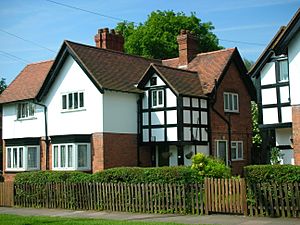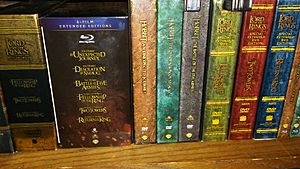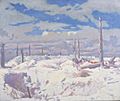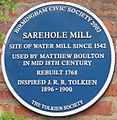J. R. R. Tolkien facts for kids
Quick facts for kids
J. R. R. Tolkien
|
|
|---|---|
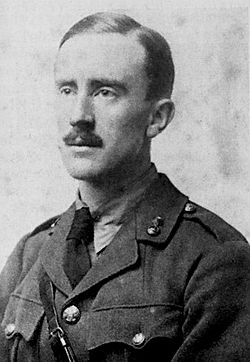
Tolkien, aged 24, in military uniform, while serving in the British Army during World War I, 1916.
|
|
| Born | John Ronald Reuel Tolkien 3 January 1892 Bloemfontein, Orange Free State |
| Died | 2 September 1973 (aged 81) Bournemouth, England |
| Occupation | Author, academic, philologist, poet |
| Nationality | British |
| Genre | Fantasy, high fantasy, translation, criticism |
| Notable works | The Hobbit The Lord of the Rings The Silmarillion |
| Spouse | Edith Bratt (1916–1971) |
John Ronald Reuel Tolkien (born January 3, 1892 – died September 2, 1973) was a famous English writer and professor. He is best known for his amazing fantasy books like The Hobbit, The Lord of the Rings, and The Silmarillion.
Tolkien was a professor at Oxford University for many years. He taught about old English languages and literature. He was also good friends with another famous writer, C. S. Lewis, who wrote The Narnia books. They were part of a group called the Inklings who met to discuss their writings.
After Tolkien passed away, his son Christopher published more of his father's writings. These books, along with The Hobbit and The Lord of the Rings, tell stories about a fantasy world called Arda and a place within it called Middle-earth. Tolkien called these stories his "legendarium."
Many people wrote fantasy stories before Tolkien. However, the huge success of The Hobbit and The Lord of the Rings made fantasy books much more popular. Because of this, Tolkien is often called the "father" of modern fantasy literature. In 2008, The Times newspaper listed him as one of the greatest British writers since 1945.
Contents
Tolkien's Life Story
J. R. R. Tolkien was born in Bloemfontein, South Africa. However, both of his parents were from England. He fought in World War I when he was a young man. After the war, he worked on the Oxford English Dictionary, which lists and explains words.
Tolkien loved languages and had studied them at Oxford University. Soon, he became a professor of English Language at the University of Leeds. Later, he became a professor at Oxford University until he retired in 1959. He was a very religious Catholic.
Tolkien married Edith Mary Bratt on March 22, 1916. They had four children: John, Michael, Christopher, and Priscilla.
His Famous Writings
Tolkien spent most of his life creating the fictional fantasy world of Middle-earth. His most famous books, The Hobbit and The Lord of the Rings, are set in this world. Because of these books, he is often called the "father of high fantasy." His work made the fantasy genre very popular.
Tolkien also wrote other books, like Farmer Giles Of Ham. He even drew the pictures and maps for The Lord of the Rings. The Lord of the Rings was published in three parts. It took him 12 years to write! These books have also been made into popular movies.
Books and Poems
- Leaf by Niggle (1945, a short story)
- Farmer Giles of Ham (1949, a medieval story)
- The Lord of the Rings (1954-1955, his most famous work)
- The Adventures of Tom Bombadil and Other Verses from the Red Book (1962, a collection of poems)
- Smith of Wootton Major (1967, a fantasy story)
- The Road Goes Ever On (1967, a song cycle)
- The Silmarillion (1977, published after his death)
- Unfinished Tales (1980, published after his death)
- The History of Middle-earth (1983-1996, a long series about his world)
- Bilbo's Last Song (1990, a poem)
- The Children of Húrin (2007, published after his death)
- The History of The Hobbit (2007, published after his death)
The Lord of the Rings became incredibly popular in the 1960s and is still loved today. It is one of the most popular books of the 20th century. In a 2003 survey by the BBC, it was voted the UK's "Best-loved Novel." People in Australia and Germany also chose it as their favorite book in other surveys. In 1999, Amazon.com customers voted it their favorite "book of the millennium."
Later Years
Tolkien's wife, Edith, passed away in 1971. Tolkien had the name Lúthien carved on her tombstone. Lúthien is a beautiful elf princess from his stories. When Tolkien died in 1973, he was buried in the same grave. The name Beren, a human hero from his stories, was added to his name on the tombstone.
Honoring Tolkien
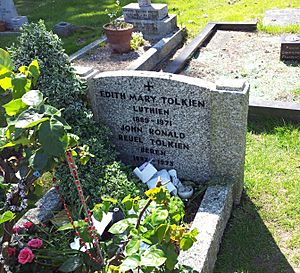
Tolkien and his characters are honored in many ways around the world. Streets, mountains, companies, and even types of animals and plants are named after them.
For example, on Titan, one of Saturn's moons, small hills are named after characters from Middle-earth. Mountains there are named after mountains in Middle-earth. There are also asteroids named after Bilbo Baggins and Tolkien himself.
Three mountains in Canada are named after Tolkien's characters: Mount Shadowfax, Mount Gandalf, and Mount Aragorn. In the Netherlands, a whole neighborhood has streets named after Tolkien and his characters. In California, USA, some housing areas also have streets named after places in Middle-earth, like Rivendell Lane.
Since 2003, The Tolkien Society has organized Tolkien Reading Day. This event happens on March 25 in schools around the world, celebrating his works.
In 2012, Tolkien was chosen as one of the British cultural icons to appear in a new version of the famous Beatles album cover, Sgt. Pepper's Lonely Hearts Club Band.
Autographs
Unlike some other authors, Tolkien did not often sign his books. Because he was so popular, his signed letters or first editions of his books are very valuable. Collectors pay a lot of money for them. For example, a signed first edition of The Hobbit from 1937 has been offered for $85,000.
Images for kids
-
Birmingham Oratory, where Tolkien was a parishioner and altar boy (1902–1911)
-
The Schwaben Redoubt, painting by William Orpen. Imperial War Museum, London
-
2 Darnley Road, the former home of Tolkien in West Park, Leeds
-
20 Northmoor Road, one of Tolkien's former homes in Oxford
-
Merton College, where Tolkien was Professor of English Language and Literature (1945–1959)
-
Bust of Tolkien in the chapel of Exeter College, Oxford
-
The Corner of the Eagle and Child Pub, Oxford, where the Inklings met (1930–1950)
-
Sarehole Mill's blue plaque
See Also
 In Spanish: J. R. R. Tolkien para niños
In Spanish: J. R. R. Tolkien para niños


